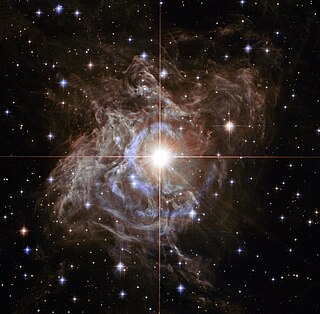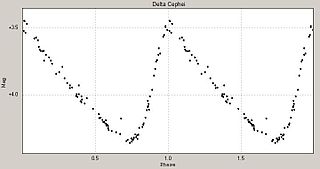
The Large Magellanic Cloud (LMC) is a satellite galaxy of the Milky Way. At a distance of around 50 kiloparsecs (160 kly), the LMC is the second- or third-closest galaxy to the Milky Way, after the Sagittarius Dwarf Spheroidal (c. 16 kpc (52 kly) away) and the possible dwarf irregular galaxy called the Canis Major Overdensity. Based on the D25 isophote at the B-band (445 nm wavelength of light), the Large Magellanic Cloud is about 9.86 kpc (32.2 kly) across. It is roughly one-hundredth the mass of the Milky Way and is the fourth-largest galaxy in the Local Group, after the Andromeda Galaxy (M31), the Milky Way, and the Triangulum Galaxy (M33).

In astronomy, a semiregular variable star, a type of variable star, is a giant or supergiant of intermediate and late (cooler) spectral type showing considerable periodicity in its light changes, accompanied or sometimes interrupted by various irregularities. Periods lie in the range from 20 to more than 2000 days, while the shapes of the light curves may be rather different and variable with each cycle. The amplitudes may be from several hundredths to several magnitudes.

A Cepheid variable is a type of variable star that pulsates radially, varying in both diameter and temperature. It changes in brightness, with a well-defined stable period and amplitude.

W Virginis variables are a subclass of Type II Cepheids which exhibit pulsation periods between 10–20 days, and are of spectral class F6 – K2.

The descriptive term long-period variable star refers to various groups of cool luminous pulsating variable stars. It is frequently abbreviated to LPV.

The red-giant branch (RGB), sometimes called the first giant branch, is the portion of the giant branch before helium ignition occurs in the course of stellar evolution. It is a stage that follows the main sequence for low- to intermediate-mass stars. Red-giant-branch stars have an inert helium core surrounded by a shell of hydrogen fusing via the CNO cycle. They are K- and M-class stars much larger and more luminous than main-sequence stars of the same temperature.

A Delta Scuti variable is a subclass of young pulsating star. These variables as well as classical cepheids are important standard candles and have been used to establish the distance to the Large Magellanic Cloud, globular clusters, open clusters, and the Galactic Center. The variables follow a period-luminosity relation in certain passbands like other standard candles such as Cepheids. SX Phoenicis variables are generally considered to be a subclass of Delta Scuti variables that contain old stars, and can be found in globular clusters. SX Phe variables also follow a period-luminosity relation. One last sub-class are the pre-main sequence (PMS) Delta Scuti variables.

RT Aurigae is a yellow supergiant variable star in the constellation Auriga, about 1,500 light years from Earth.

The Optical Gravitational Lensing Experiment (OGLE) is a Polish astronomical project based at the University of Warsaw that runs a long-term variability sky survey (1992–present). The main goals are the detection and classification of variable stars, discovery of microlensing events, dwarf novae, and studies of the structure of the Galaxy and the Magellanic Clouds. Since the project began in 1992, it has discovered a multitude of extrasolar planets, together with the first planet discovered using the transit method (OGLE-TR-56b) and gravitational microlensing. The project has been led by professor Andrzej Udalski since its inception.

W Mensae is an unusual yellow supergiant star in the Large Magellanic Cloud in the southern constellation Mensa. It is an R Coronae Borealis variable and periodically decreases in brightness by several magnitudes.

R136b is a Wolf–Rayet star in the R136 cluster in the Large Magellanic Cloud. It is one of the most massive and most luminous stars known. It is found in the dense R136 open cluster at the centre of NGC 2070 in the Tarantula Nebula.
Beta Fornacis is the Bayer designation for a solitary star in the southern constellation of Fornax. It is visible to the naked eye with an apparent visual magnitude of 4.46. Based upon an annual parallax shift of 18.89 mas, it is located around 173 light years away from the Sun. At that distance, the visual magnitude is reduced by an interstellar extinction factor of 0.1.

WOH G64 is an unusual red supergiant (RSG) star in the Large Magellanic Cloud (LMC) satellite galaxy in the southern constellation of Dorado. It is one of the largest known stars, being described as possibly being the largest star known. It is also one of the most luminous and massive red supergiants, with a radius calculated to be around 1,540 times that of the Sun (R☉) and a luminosity around 282,000 times the solar luminosity (L☉).

Stellar pulsations are caused by expansions and contractions in the outer layers as a star seeks to maintain equilibrium. These fluctuations in stellar radius cause corresponding changes in the luminosity of the star. Astronomers are able to deduce this mechanism by measuring the spectrum and observing the Doppler effect. Many intrinsic variable stars that pulsate with large amplitudes, such as the classical Cepheids, RR Lyrae stars and large-amplitude Delta Scuti stars show regular light curves.

Classical Cepheids are a type of Cepheid variable star. They are young, population I variable stars that exhibit regular radial pulsations with periods of a few days to a few weeks and visual amplitudes ranging from a few tenths of a magnitude up to about 2 magnitudes. Classical Cepheids are also known as Population I Cepheids, Type I Cepheids, and Delta Cepheid variables.

Melnick 42 is a massive blue supergiant star in the Tarantula Nebula in the Large Magellanic Cloud located in the constellation Dorado. Although it is only 21 times the size of the sun, its high temperature of 47,300 K makes it one of the most luminous stars of the Tarantula Nebula at 3,600,000 L☉. It is less than two parsecs from the centre of the R136 cluster, although that is well outside the central core.

BL Herculis variables are a subclass of type II Cepheids with low luminosity and mass, that have a period of less than eight days. They are pulsating stars with light curves that frequently show a bump on the descending side for stars of the shortest periods and on the ascending side for longer period stars. Like other type II Cepheids, they are very old population II stars found in the galaxy’s halo and globular clusters. Also, compared to other type II Cepheids, BL Herculis variables have shorter periods and are fainter than W Virginis variables. Pulsating stars vary in spectral class as they vary in brightness and BL Herculis variables are normally class A at their brightest and class F when most dim. When plotted on the Hertzsprung–Russell diagram they fall in-between W Virginis and RR Lyrae variables.
The Araucaria Project is an international science collaboration focused on improving the calibration of the extragalactic distance scale based on observations of major distance indicators in several nearby galaxies.

OGLE-LMC-CEP0227 is an eclipsing binary and Cepheid variable star, pulsating every 3.8 days. The star, in the Large Magellanic Cloud, was the first Cepheid star system found to be orbiting exactly edge on.

In astronomy, a period-luminosity relation is a relationship linking the luminosity of pulsating variable stars with their pulsation period. The best-known relation is the direct proportionality law holding for Classical Cepheid variables, sometimes called the Leavitt law. Discovered in 1908 by Henrietta Swan Leavitt, the relation established Cepheids as foundational indicators of cosmic benchmarks for scaling galactic and extragalactic distances. The physical model explaining the Leavitt's law for classical cepheids is called kappa mechanism.



















